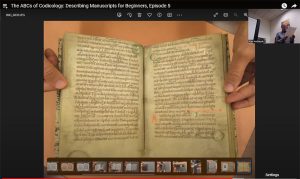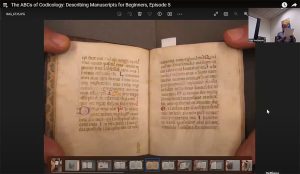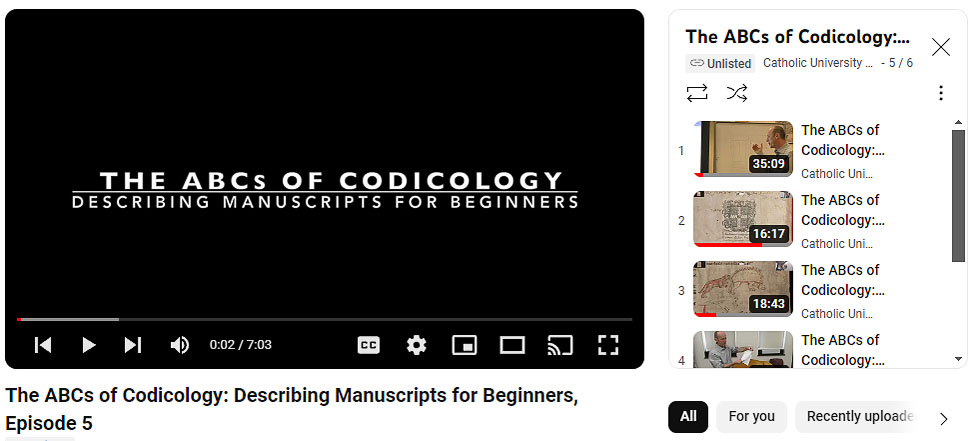It is often hard to forget your first encounter with a truly antique printed book, looking impressive with its wooden boards and brass clasps, or a medieval manuscript that breathes even more ancient history. Most of us experience this deep feeling of almost reverent awe at looking at or touching it with one’s bare hands (“Wait, no white gloves? Is it safe for the book?”), when one thinks not of decades, but centuries of history this very object has witnessed and of numerous people, scribes, readers, and scholars, who created, owned, or held it in their hands five, six, eight, or even more centuries back.
 Thanks to this wonderful initial “awe” moment, a person starts seeing a book or a manuscript (which literally means “written by hand”) not only as simple text, multiple copies of which may often be obtained elsewhere, but as a unique historical artifact, which, when properly understood, may reveal a lot on its own history and background as well as on the history of the eras and locations it has witnessed. And then, naturally, we get curious and many questions arise in our minds regarding the object’s creation, history, text, structure, physicality, and other features.
Thanks to this wonderful initial “awe” moment, a person starts seeing a book or a manuscript (which literally means “written by hand”) not only as simple text, multiple copies of which may often be obtained elsewhere, but as a unique historical artifact, which, when properly understood, may reveal a lot on its own history and background as well as on the history of the eras and locations it has witnessed. And then, naturally, we get curious and many questions arise in our minds regarding the object’s creation, history, text, structure, physicality, and other features.
It may be easier to find answers working with printed books, which often contain some information on their manufacturing history and multiple copies of which may be available around, but it’s much less obvious with manuscripts. They may make us ponder, how do we know this particular manuscript was made in thirteenth-century France, and not in late fifteenth-century England? How many scribes and other people were involved in its production? What materials is it made of? Is the binding contemporary or late? Who owned it? What can the ink or other physical elements tell us about the time or region of its creation? And we can go on and on.
Getting to know a manuscript is not unlike getting to know a person. To find the answers, you start with a proper conversation, which requires that you ask various (sometimes, very specific) questions, patiently look for answers, and, paraphrasing Sherlock Holmes [1], learn to observe, not only see. The answers (well, at least some of them) may often be found inside this very manuscript if one only knows where to look for them and how to interpret the observed.
 Developing such skills is an essential part of training for all scholars and professionals working with manuscripts, and several departments at the Catholic University of America regularly offer such opportunities to their students by hosting specialized class sessions or workshops and introducing them to the two major disciplines related to manuscripts: paleography, a study of historical handwriting, and codicology (from Latin “codex” = “a book” and Greek “logia” = “study (of)”), which studies the manuscripts as physical artifacts and focuses on their materials, structure, illustrative and textual content, physical elements and characteristics, and various other features.
Developing such skills is an essential part of training for all scholars and professionals working with manuscripts, and several departments at the Catholic University of America regularly offer such opportunities to their students by hosting specialized class sessions or workshops and introducing them to the two major disciplines related to manuscripts: paleography, a study of historical handwriting, and codicology (from Latin “codex” = “a book” and Greek “logia” = “study (of)”), which studies the manuscripts as physical artifacts and focuses on their materials, structure, illustrative and textual content, physical elements and characteristics, and various other features.
Catholic University Special Collections’ Rare Books, being well equipped with a great manuscript collection, is always happy to take part in these events, hosting or co-hosting them and ensuring hands-on experience for all participants.
Such classes and workshops, though extremely valuable for the students, always draw the interest of more people than they can accommodate, so, in an attempt to make it accessible to a wider audience, including all interested among our students, broader academic community, and the general public, we are happy to announce a six-part video series called “The ABCs of Codicology: Describing Manuscripts for Beginners”, in which Dr. Ilya Dines, a visiting scholar, historian, and codicologist, who has previously conducted multiple classes and workshops on this topic at the CatholicU, will introduce and explain the basics of codicology and manuscript description to everyone.

Dr. Dines received his Ph.D. from the Hebrew University of Jerusalem, with a dissertation on the Critical Edition of Bestiaries of the Third Family. He completed his postdoc at the University of Cologne and later worked at the University of Cambridge and other academic institutions and libraries worldwide. He came to the United States in 2015, as a recipient of a Kluge fellowship at the Library of Congress, where he worked until 2022. He is the author of 2 books, 20 articles, and several electronic catalogs. In recent years, he has become increasingly interested in codicology and paleography. From these pursuits, the idea emerged to create a small, accessible course that would help librarians and new scholars describe manuscripts without being professional codicologists.
These videos were recorded in 2023 at the Catholic University of America, Special Collections’ Rare Books reading room and are now freely available on YouTube: “The ABCs of Codicology”. So, please, follow the link, if you would like to learn more about manuscripts and manuscript description, and send us an email at lib-rarebooks@cua.edu if you think of scheduling an appointment to see some manuscripts in our collection in person.
References:
[1] “You see, but you do not observe.” Sir Arthur Conan Doyle, A Scandal in Bohemia, 1891.

One thought on “The Archivist’s Nook: ABCs of Codicology – Free guide to knowing your manuscript”